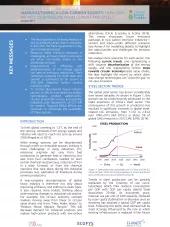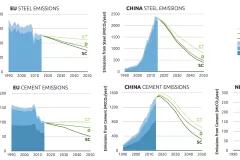The EU cement sector has made progress to reduce emissions in the past three decades, yet there is a long way ahead for the carbon-intensive industry to decarbonise. In this study, potential decarbonisation pathways are developed and analysed based on different highly innovative technology routes. Based on the results, challenges and opportunities related to specific technologies are identified, informing policy recommendations for the near-, mid- and long term.
Main findings:
The characteristics of the traditional cement production process, with its major part of emissions originating from its chemical process emissions, complicates deep emission reductions in the sector. As of 2020, emission reductions have mainly been achieved by reducing energy related emissions through energy efficiency and fuel switch, so called low-hanging fruits. In order to further cut emissions, innovative technologies and production routes yet in the development phase must be considered.
To target process emissions, three main options are at the table:
- Reduction of the clinker to cement ratio using supplementary cementitious materials (SCMs)
- Production of new cements using alternative binders
- Carbon Capture and Storage (CCS)
These three mitigation options have certain limitations related to raw material availability, end-use applications and storage availability. The study presents two high innovation scenarios, the High Innovation Capture scenario (HIC-S) and the High Innovation Processes scenario (HIP-S), to analyse the emission reduction potential of different technologies. The HIC-S is highly dependent on CCS while the HIP-S is focused on novel cements and SCMs.
The study finds similar mitigation potential from the two routes, albeit with significantly differentiating deployment requirements. A common factor among the both routes is the need for CCS in both routes. Even though the HIP-S has less focus on CCS, there will still be a need for it to reach near-zero emissions by 2050. A second common factor is the limited possible roll-out of technologies pre-2030. As these technologies are still in the development phase, a period of about ten years is still expected to be required for the piloting and demonstration of those to be prepared for commercialisation.
Importantly, that does not translate to low action potential in the same period. In the near- to medium term, a cement sector decarbonisation strategy should be developed, identifying the most suitable technology route for the EU cement sector. Based on that, funding programmes focusing on research and development, pilot and demonstration projects should be established.
Based on the technology route, the required infrastructure development, mapping of potential storage sites as well as raw material supply chains should be developed. In addition, standards should be continuously updated and revised in line with research and technology development. By doing so, full roll-out of new technologies should be feasible by 2030, after which emission reductions could be achieved at a rapid rate, reaching near-zero emissions by 2050.
That is, given the limited emission reduction potential pre-2030, the analysis suggests alternative ways to increase ambition and set objectives in that time frame, particularly related to NDC updating processes and Long-term Strategy (LTS) planning. In the short term, a sector level dialogue could be initiated where a roadmap for the decarbonisation of the EU cement sector is determined. Such roadmap should reflect the objectives of the European Green Deal. In the mid- and long term, further conceptualisation could be ensured through a dedicated investment plan in R&D, building on existing programmes and initiatives. That would facilitate a systematic introduction of novel techniques in the long term, including adjustments to the legislative framework and ensuring a common vision between the public and the private sector.







